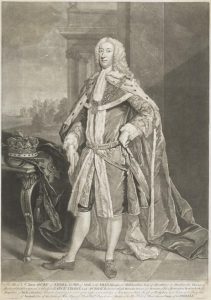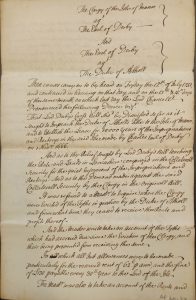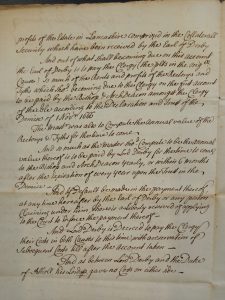The Atholl Papers: The 2nd Duke of Atholl’s Inheritance of the Isle of Man
For the poor souls amongst you that managed to get through my first blog post and, having decided you hadn’t suffered enough, have come back for more, we turn to the rather dry (but very important!) topic of how a Scottish noble family came into possession of the Isle of Man. It is here that we introduce the first of the three dukes represented in the papers, and the man who inherited the island: James Murray, 2nd Duke of Atholl (1690-1764). But as you’ll soon find out, his inheritance did not come without a fight.
Portrait of James Murray, 2nd Duke of Atholl, by Johannes Faber (Courtesy of National Galleries Scotland)
Prior to the 2nd Duke’s accession to the title of ‘Lord of Man’ in 1736, the island had been ruled by the Stanley family (later the Earls of Derby) since 1405, originally under the title of ‘King of Man,’ but as the earls were vassals to the King of England, the former title was eventually adopted. There was a break in their rule between 1595 and 1609, when a dispute broke out between the daughters and widow of Ferdinando (a fine Lancastrian name), the 5th Earl of Derby, and William, the newly minted 6th Earl. While the two parties squabbled over the Isle of Man, the island itself was vested into the British Crown, until it was agreed that William would purchase the isle from Ferdinando’s daughters. The title ‘Lord of Man’ would be enshrined in law in 1609, along with the condition that the island would be inherited by William’s descendants. It is as a consequence of this Act of 1609 that the Isle of Man would eventually come into the hands of the 2nd Duke of Atholl.
When the 10th Earl of Derby died in February 1736, without any surviving issue, the earldom was inherited by a distant male relation, Sir Edward Stanley of Bickerstaffe, but the Isle of Man reverted to the heirs of William, specifically the heirs of his son, James, 7th Earl and Baron Strange. Until 1732, the heir apparent had been the daughter of the 9th Earl, Lady Henrietta Ashburnham, Baroness of Strange; but upon her death the Duke became the next in line to inherit the island (and the Barony of Strange), as the grandson and eldest living heir (not attainted) of Lady Amelia Anne Sophia Stanley, daughter of the 7th Earl.
Family tree showing the 2nd Duke’s claim to the Isle of Man and the Barony of Strange (no reference number)
From the papers, it is clear that the Duke of Atholl was well aware that, following the death of Henrietta, he stood to inherit the Isle of Man when the 10th Earl passed; a fact that did not go unnoticed by the members of the Earl’s own family. A letter received by the Duke’s London-based solicitor, Alexander Ross, from an informant in February 1733 (Ref. AP X73 (2nd)-8), discloses the concerns held by relatives of the 10th Earl and the potential loss of estates going to the Duke, as a consequence of the Earl not having a will. These worries were further heightened by their reluctance to broach the subject with him, lest they be disinherited, due to his disposition. But the Duke also had his own concerns on the matter, seeking legal advice on whether the island would go to himself or his attainted older brother, William; and also enquiring into whether the Earl had the right to dispossess him in favour of another relative, contrary to the Act of 1609.
The Duke moved swiftly upon hearing the news of the 10th Earl’s death, in early 1736, sending a petition to the King for permission to pay homage as the ‘undoubted Lord and proprietor’ of the Isle of Man (Ref. AP X2 (1st)-3). It is presumed that his petition was accepted, as there is no acknowledgement in the papers, and later in March 1736 the Duke’s first Governor, James Murray, Receiver General of Scotland, arrived on the island to establish his rule over the inhabitants. The Duke would follow suit in June of that year; found in the papers are several copies of a detailed account of his journey from Liverpool and arrival onto the island, followed by his first attendance at a Tynwald Court as Lord of Man.
Extract from an account of the 2nd Duke’s first visit to the Isle of Man (Ref. AP X74-33)
Sir Edward Stanley of Bickerstaffe, now the 11th Earl of Derby, would challenge the Duke’s inheritance of the island, producing a will purported to have been made near the end of the late Earl’s life, which bequeathed the isle and several Lancashire estates to him rather than the Duke of Atholl. To what extent this will was genuine is unknown, but the Duke took it seriously enough and his agents were dispatched to investigate the matter. They reported back that the late Earl had been infirm and under the influence of the 11th Earl’s agents by the time of his passing. The Duke would respond to this challenge to his right to be Lord of Man by sending a Bill of Complaint to Baron Hardwicke, Lord High Chancellor of Great Britain, with accusations that the present Earl and his brothers had fabricated the document (Ref. AP 60 (2nd)-6).
Fabricated or not, the Earl used the existence of this will to press what he believed to be his rights on the island, and to generally be a nuisance. Letters from Governor Murray, between 1736 and 1737, detail attempts by the Earl’s agents to remove property and goods from the isle, along with orders for Receiver General Charles Stanley to send money believed to be owing to him, and threats of punishment if he did not comply. As the late Earl’s will remained unproven, the Manx officials resisted these efforts to undermine the Duke’s authority. Undeterred, the 11th Earl sent a petition to the King in 1738, declaring himself the rightful Lord of Man, and that the Duke had taken the island without his ‘privity or consent,’ and requested that the isle be returned to him (Ref. AP X34-12).
While the 11th Earl of Derby began his legal challenge for the island, there was another dispute simmering in the background between himself and the clergy of the Isle of Man; one which would be used by the Duke of Atholl as part of his efforts to retain his lordship over the isle. In 1666, Charles, 8th Earl of Derby, sold the island’s impropriate tithes (tithes received by a layperson) to the clergy for their relief and that of certain schoolmasters. However, as it was unclear whether the 8th Earl actually had the right to do this, the Bishop of Sodor and Man bought the tithes, with the Earl’s Lancashire estate of Bispham used as security. Upon inheriting the island, the Duke took back possession of these tithes, though he continued to allow the clergy to receive payments from this fund; that is, until November 1744, when he ordered Governor Patrick Lindesay to stop the payments to them, in order to force the clergy to bring a case against the 11th Earl for the loss of the tithes, and thus increase the financial pressure upon him. Finally pushed to act, the clergy did as the Duke hoped and brought a case against the Earl before the Court of Chancery.
Extract from a draft letter from the 2nd Duke to Governor Patrick Lindesay (Ref. AP X73 (1st)-21)
The disputes over the island and the impropriate tithes would drag on for a number of years and it was not until 1751 that both matters were settled before the Court of Chancery. On 15th July, the Lord Chancellor decreed the Earl’s case against the Duke dismissed, and also ordered him to pay the clergy of the Isle of Man an annual sum based on the value of the impropriate tithes. Though the Earl was not ordered to cover the Duke’s legal fees, it remained a costly defeat for him. Emboldened by his victory, the Duke would continue the conflict between the Earl and himself, attempting to claim the entirety of the late 10th Earl’s estate, though he would be unsuccessful in this endeavour.
Minutes of Lord Chancellor’s decree concerning the Earl of Derby’s cases with the Duke of Atholl, and the Bishop of Sodor and Man (Ref. AP 60-23)
It is here that we come to the end of this particular story; the intricacies of which have been very much simplified for the sake of brevity, but I hope still provides you with a good overview of how the Isle of Man was inherited by the 2nd Duke of Atholl.
In the next blog post, to be released at the end of September, we move on to the fascinating and rather unsavoury social phenomenon that was Irish marriage abductions, and instances of these cases found in the Atholl Papers.
Read The Atholl Papers Blog:
The Case of Carolina Elinora Mahon
The Atholl Papers: An Introduction to the Project
Gareth Pugh
Manx National Heritage Project Archivist (The Atholl Papers)
Blog Archive
- Edward VII’s Coronation Day in the Isle of Man (9 August 1902)
- Victoria’s Coronation Day in the Isle of Man (28 June 1838)
- Second World War Internment Museum Collections
- First World War Internment Museum Collections
- Rushen Camp: Second World War Internment on the Isle of Man
- Hutchinson, Onchan & Peveril Camps: Second World War Internment on the Isle of Man
- Douglas Promenade: Second World War Internment on the Isle of Man
- Mooragh Camp: Second World War Internment on the Isle of Man
- Sculpture collection newly released to iMuseum
- Fishing Folklore: how to stay safe & how to be lucky at sea
- News from the gaol registers project: remembering the men and women who served time in Castle Rushen
- Explore Mann at War: stories of Manx men, women and children in conflict
- We Will Remember Them: Isle of Man Great War Roll of Honour (1914-1918)
- Dr Dave Burnett explores Manx National Heritage geology collection
- Unlocking stories from the Archives: The Transvaal Manx Association
- Login to newspapers online: step-by-step guidance
- ‘Round Mounds’ Investigation Reveals Rare Bronze Age Object






